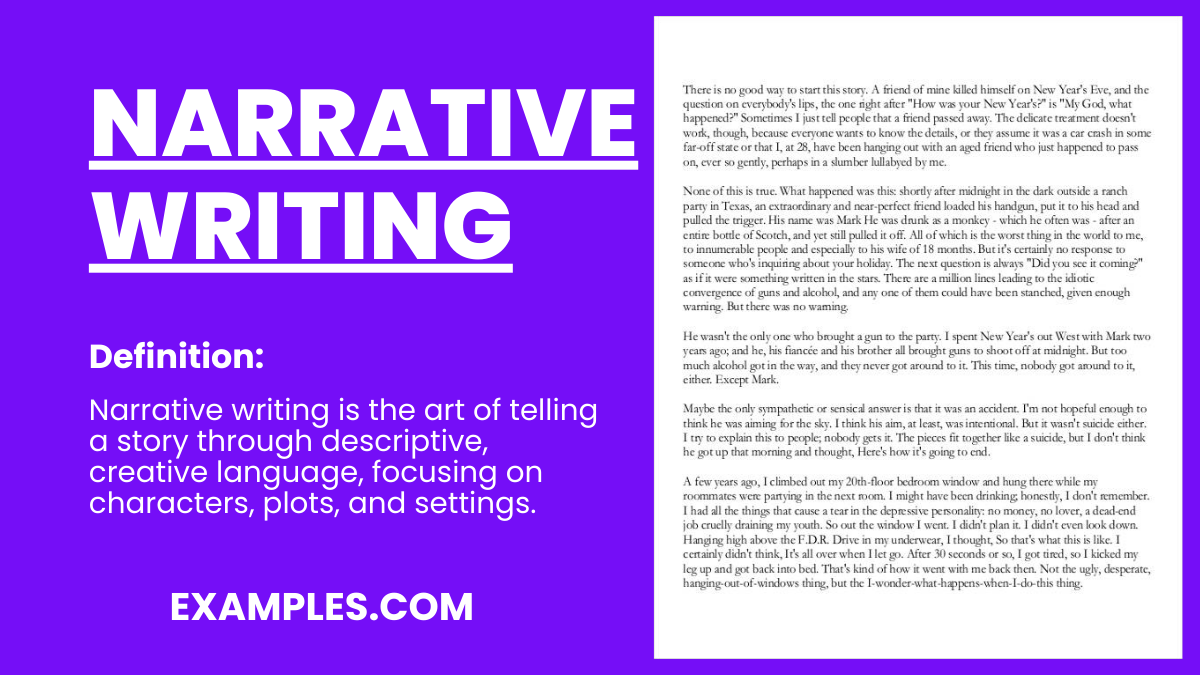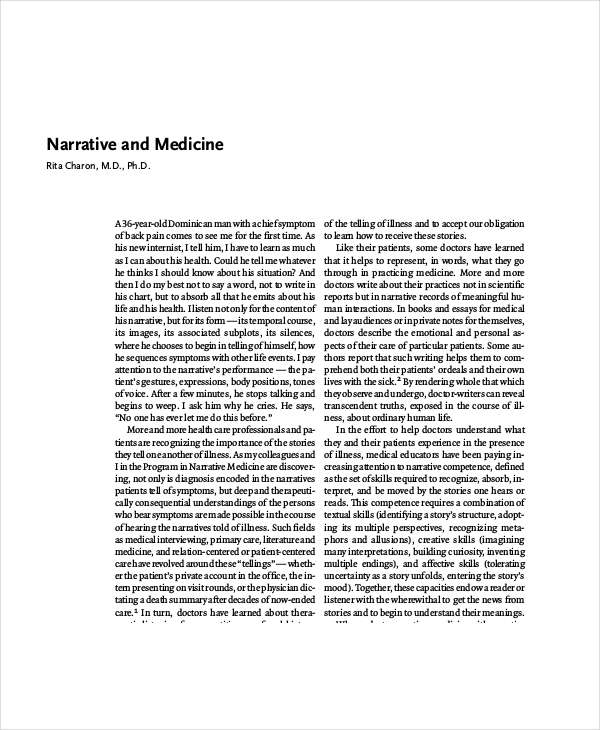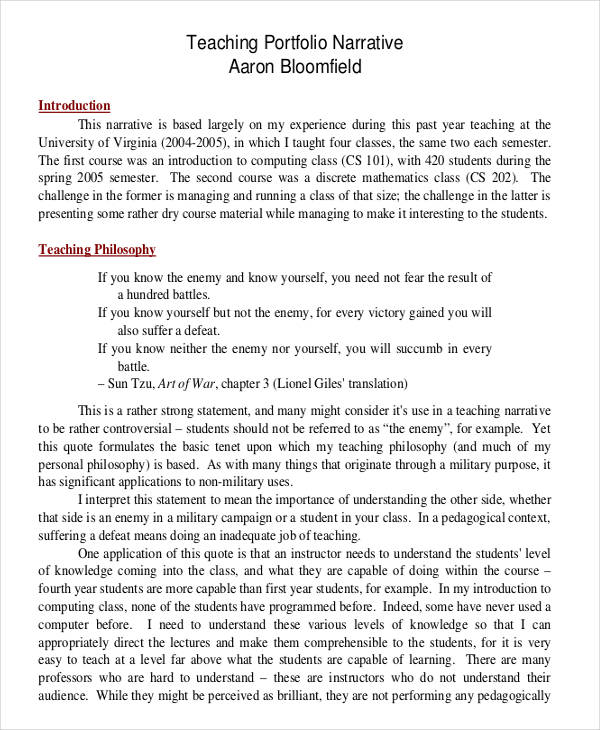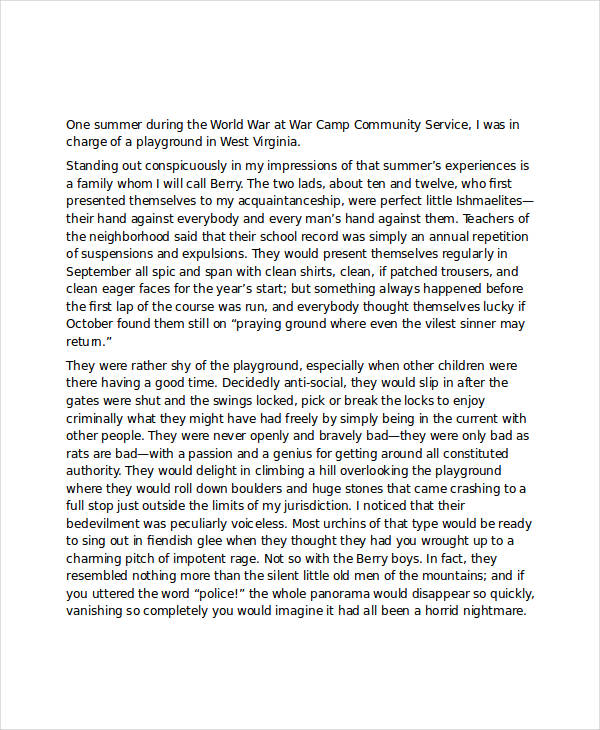5+ Narrative Writing Examples to Download
Narrative writing is a captivating storytelling method that allows writers to share their personal experiences, imaginative tales, or historical events. It’s a powerful tool for engaging readers through vivid descriptions, emotional depth, and a well-structured plot. By blending creativity with narrative techniques, this form of writing transports readers into the heart of the story, making every moment feel real and impactful. It’s an art that balances entertainment, reflection, and clarity, turning simple stories into memorable journeys.
At an early age, we have been exposed to the different writing styles and types. We were taught of such writing styles, and we learned to distinguish the differences each writing style has with each other. Over time, we might have even tried writing various writing styles.
In short, use of writing has always been part of our lives, and it will remain that way. Here, we will recall one of the writing styles we have learned as a child, one we’re very familiar with—narrative writing.
What is Narrative Writing?
Narrative writing is a style of writing where the author tells a story. This story can be real or fictional, and it usually follows a specific structure with a beginning, middle, and end. The key elements of narrative writing include characters, a plot, a setting, a climax, and a conclusion. It differs from other types of writing by its focus on storytelling, often using detailed descriptions and emotional language to engage the reader’s imagination and feelings.
Structure/Format of Narrative Writing
Narrative writing has a distinct structure that helps in organizing the story and making it engaging and coherent. This structure typically includes the following elements:
Introduction
Hook: Begins with a sentence that captures the reader’s attention.
Setting: Establishes the time and place where the story occurs.
Characters: Introduces the main characters involved in the story.
Purpose: If relevant, states the reason or theme of the narrative.
Body
Events: Describes the sequence of events in a clear, chronological order. However, flashbacks or non-linear storytelling can be used effectively.
Conflict: Introduces a problem or challenge faced by the characters.
Development: Shows how characters react to events and evolve.
Sensory Details: Uses descriptive language to engage the reader’s senses and emotions.
Climax
Turning Point: The most intense or crucial moment of the story, where the main conflict reaches its peak.
Emotional Engagement: This part should be the most engaging and is often the result of the buildup of events in the body.
Conclusion
Resolution: Provides closure to the story, resolving any conflicts or issues.
Reflection: Offers insight or lessons learned from the events of the story.
Final Thoughts: Leaves the reader with something to think about, often tying back to the introduction or the theme of the narrative.
What does narrative writing include?
Narrative writing includes several key elements that work together to create an engaging and coherent story. These elements are:
- Plot: The sequence of events that make up the story. It includes the setup, conflict, climax, and resolution.
- Characters: The individuals involved in the story. Main characters are usually more fully developed and central to the plot.
- Setting: The time and place where the story occurs. This can include not just physical locations, but also the social, economic, or cultural environments.
- Point of View: The perspective from which the story is told. Common points of view include first-person (using “I” or “we”) and third-person (using “he,” “she,” or “they”).
- Conflict: The challenge or problem around which the plot revolves. Conflict can be internal (within a character) or external (between characters or between a character and their environment).
- Theme: The underlying message or meaning of the story. Themes can be explicit or implied through the events and outcomes of the narrative.
- Dialogue: The conversations between characters, which can reveal their personalities, relationships, and contribute to plot development.
- Descriptive Language: Vivid descriptions that engage the reader’s senses and emotions, bringing the story to life.
Examples of Narrative Writing
“The Last Lesson” by Alia Marquez
In “The Last Lesson,” Alia Marquez explores the poignant moments of a teacher’s final day at a troubled inner-city school. The narrative delves deep into her emotional farewell, capturing the profound impact of her years spent shaping young minds.
“Standing at the threshold of the classroom, I could feel the weight of every moment spent within these walls. It wasn’t just a place of learning; it was a sanctuary for lost hopes and hidden potentials unearthed.”
“Echoes of the Past” by Samuel Clark
Samuel Clark’s memoir, “Echoes of the Past,” recounts his journey through the landscapes of his childhood during the Great Depression. His vivid descriptions and introspective reflections offer readers a deeply personal view of resilience and survival.
“As I wandered through the barren fields of my youth, each footstep seemed to stir the dust of forgotten dreams. The echoes of laughter and sorrow intertwined, painting a tapestry of memories in the stark landscape.”
“Beneath the Surface” by Elena Watkins
In her compelling essay, Elena Watkins invites readers into her world as a marine biologist working in the mysterious depths of the Pacific Ocean. Her narrative captures the thrill of discovery and the relentless pursuit of knowledge.
“Each dive was a descent into a new universe. The vibrant corals and elusive creatures that thrived in the ocean’s abyss were not just subjects of study but messengers from a world beneath waves, whispering secrets of the deep.”
“A Journey to Forgiveness” by Marcus Yi
Marcus Yi’s narrative essay details his emotional pilgrimage to his ancestral home in China, where he confronts the legacy of estrangement and seeks reconciliation. His heartfelt narrative explores themes of identity, belonging, and healing.
“The old elm tree stood as a sentinel at the family estate, its branches stretching out like arms ready to embrace. Beneath its shade, I found not just the roots of my family tree but a pathway to forgiveness, winding through the years of silence.”
“Moments of Joy” by Olivia Thompson
Olivia Thompson reflects on the simple pleasures that punctuate our daily lives in her narrative piece. With a gentle voice and keen observation, she illustrates how these fleeting moments create a tapestry of joy that sustains us.
“Joy found me in the quiet morning hours, in the soft murmur of the rain against the windowpane, and in the laughter of children chasing the wind. It was never loud or demanding; it was the quiet guest at the table of daily life, always present and graciously subtle.”
Types of Narrative Writing
Fictional Narrative
- Characteristics: Involves created storylines, characters, and settings. These narratives can range from realistic to fantastical.
- Purpose: Primarily for entertainment, but they can also explore themes, moral dilemmas, or human experiences.
- Examples: Novels, short stories, fairy tales.
Non-Fictional Narrative
- Characteristics: Based on real events and people. While factual, they are presented in a narrative style, making them more engaging.
- Purpose: To inform or educate about real-life events or experiences, often with an emphasis on historical, biographical, or autobiographical elements.
- Examples: Memoirs, historical accounts, travelogues.
Autobiographical Narrative
- Characteristics: The writer narrates their own life experiences. It can include personal stories, reflections, and significant life events.
- Purpose: To share personal insights and experiences, often highlighting a particular theme or period in the writer’s life.
- Examples: Autobiographies, personal essays.
Biographical Narrative
- Characteristics: Biographical Narrative Focuses on the life story of another person. These narratives delve into the experiences, achievements, and impact of the subject.
- Purpose: To explore and share the life of the subject, providing insights into their personality and contributions.
- Examples: Biographies, historical profiles.
Historical Narrative
- Characteristics: Historical Narrative stories are set in a historical context. They can be a factual recounting of historical events or a fictional story set in a historical period.
- Purpose: To educate about and bring to life historical events or eras, often connecting the past to present-day themes.
- Examples: Historical novels, documentaries.
Adventure Narrative
- Characteristics: Centers on stories of adventure, exploration, or extraordinary experiences. Often includes elements of risk and excitement.
- Purpose: To entertain and engage the reader with tales of adventure, often highlighting themes of bravery, exploration, or survival.
- Examples: Adventure novels, travel narratives.
Mystery Narrative
- Characteristics: These stories involve a mystery, puzzle, or unexplained event, with a focus on the process of solving the mystery.
- Purpose: To intrigue and captivate the reader, often involving suspense, clues, and detective work.
- Examples: Detective stories, suspense novels.
Narrative Writing Samples
Personal Narrative Writing
Medical Narrative Sample
Purpose of Narrative Writing
Narrative writing is primarily intended to tell a story to its readers. It is typically presented in a way that engages the writers to imagine themselves as the main character of the story. In narrative writing, the sequence of events is presented such that the reader may be able to follow the flow of events.
The writer incorporates feelings into the composition which lets the reader “feel” what they are reading. Aside from that, the writer also vividly describes the elements of the composition in detail, allowing the reader to paint a picture of it in mind. To sum it up, the business writing writers compose a narrative with the intention of entertaining the readers.
Interactive Narrative Sample
Reflective Writing
Teaching Narrative Example
Free Narrative Writing
How to Compose a Narrative Essay
In narrative essay writing, the writer needs to be imaginative, and at the same time creative in order to create a story which not only catches the readers’ attention but also retains it, things about writing papers. If you’re struggling in doing so, here are some points to remember for you to improve your composition.
- Choose a topic. Pick one which can easily be narrated. Your topic should not only interest you, but also your readers. An interesting topic will be the foundation of an interesting story.
- Create an outline of the plot. This will help you in organizing the sequence of events in your story.
- Be consistent. Decide whether to use the third person or first person point of view in your composition. Also be mindful of the tense you use.
- Carefully describe the elements of the story. Describe the characters, setting, events, and other elements of the story in full detail.
- Avoid over-describing details. This goes especially to movements. Carefully narrate the elements of your story, but do not overdo it.
- Mind your word choice. Strong words create strong sentences, which usually interests readers. Still, keep your language simple and clear.
- Proofread your composition. Or let a friend do it. But make sure you polish your composition before publishing (if you plan to).
Characteristics of Narrative Writing
Narrative writing has distinct characteristics that set it apart from other types of writing. Understanding these features is essential to crafting a compelling narrative:
- Story Structure: It follows a traditional structure of beginning, middle, and end.
- Characters: Involves well-developed characters who drive the story.
- Setting: Features a specific time and place where the story unfolds.
- Plot and Conflict: Centers around a central conflict or challenge, with a climax and resolution.
- Point of View: Typically narrated from a first-person or third-person perspective.
- Descriptive Language: Uses vivid descriptions to create a sensory experience for the reader.
- Dialogue: Includes conversations between characters to advance the plot and develop characters.
Tips for Narrative Writing
1. Choose a Compelling Topic: Select a story that is meaningful and interesting to you. Personal experiences often make for engaging narratives.
2. Plan Your Narrative: Outline the structure of your story, including key events, character development, and the resolution.
3. Create Vivid Characters: Develop well-rounded characters with distinct personalities, backgrounds, and motivations.
4. Set the Scene: Use descriptive language to build your setting, making it as detailed and vivid as possible.
5. Build the Plot Around a Conflict: Introduce a central conflict or challenge that drives the story and holds the reader’s interest.
6. Use Dialogue Effectively: Incorporate dialogue to reveal character traits and advance the plot. Ensure it sounds natural and consistent with the characters.
7. Show, Don’t Just Tell: Rather than simply stating facts, show the action through descriptive details, characters’ actions, and dialogue.
8. Maintain a Consistent Point of View: Stick to one narrative perspective to avoid confusing the reader.
How Should I Start a Narrative Writing?
Begin with a hook that grabs attention, set the scene, introduce key characters, and hint at the central conflict or theme.
What is an Example of a Narrative Writing?
A narrative writing example could be a personal story about overcoming a challenge, with descriptive details, character growth, and emotional depth.
What is a Nonlinear Narrative?
A nonlinear narrative breaks from chronological order, using flashbacks or jumps in time to enhance storytelling and intrigue.
Mastering narrative writing involves understanding its key elements and applying them effectively. By choosing a compelling topic, developing rich characters, setting a vivid scene, and weaving a plot around a central conflict, your narrative will captivate readers. Remember, the power of a well-told story lies in its ability to connect emotionally with the audience.








